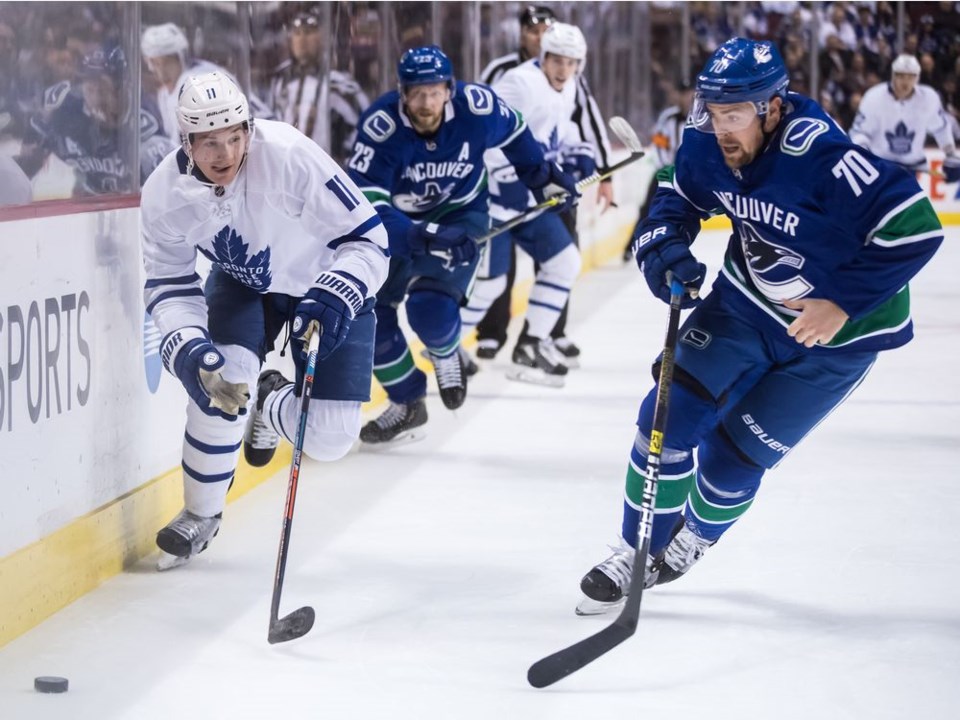The Canucks’ decision to walk away from Derrick Pouliot and let him go to free agency cut off a branch on one particular tree: the remains of the roster that Jim Benning inherited when he became general manager of the Canucks.
One of the main defences mounted by Benning’s most ardent supporters is that he walked into a very difficult situation when he was hired as GM. The prospect pool was limited, with only Bo Horvat and Ben Hutton going on to make a significant impact. Most of all, Benning didn’t have much to work with to acquire more picks and prospects; as it’s frequently put, in order to make a trade, you need to have players that other teams want.
The New York Rangers, for instance, made a strong declaration last February that they were rebuilding and immediately traded Nick Holden, Michael Grabner, Rick Nash, Ryan McDonagh, and J.T. Miller for a bevy of picks and prospects. Those were evidently players that other teams wanted and it led to the Rangers picking three times in the first round of the 2018 draft. The Kevin Hayes trade at this year’s trade deadline netted them an additional first-round pick in the 2019 draft.
Along with the extra first-round picks, the Rangers have acquired additional picks throughout the draft, to the point that they felt comfortable sending two of those picks to the Carolina Hurricanes to acquire prospect defenceman Adam Fox. Whatever you may think of the Rangers’ approach to rebuilding, it’s clear that they leveraged their roster for as many pieces for the future as they could.
Benning and the Canucks took a very different approach. When Benning was first hired, rebuilding wasn’t on the menu. It seems clear that Francesco Aquilini wanted a quick return to the playoffs, Benning promised exactly that, and, for one season, he delivered. Regrettably, the Canucks haven’t made the playoffs since, forcing them into a rebuild whether they like it or not.
It does make me wonder what happened to the roster that Benning inherited. Were the players on that roster really so untradeable? What pieces for the future did Benning manage to extract from that group?
Pouliot was one of those pieces, but he ended up not being part of the future for the Canucks. Who else still remains?
To start off, let’s look at a big ol’ list of players that were on the Canucks’ 2013-14 roster, as well as a smattering of select prospects in the system at the time.
A BIG OL’ LIST
These were the players that Benning had to work with when he arrived and it shows how they left the team: whether they were traded, waived, bought out, or if they left in free agency or retired.
Just three players active in the 2013-14 season with the Canucks remain with the team: Alex Edler, Chris Tanev, and Jacob Markstrom. Obviously, Bo Horvat, Ben Hutton, and Brendan Gaunce were in the system and remain with the Canucks, though Gaunce is a restricted free agent and it remains to be seen if he’ll be re-signed. There’s also Alex Biega, who played the 2013-14 season entirely in Utica.
That’s a lot of roster turnover in five years, but it makes sense for a team trying to get younger. Normally teams do that by trading their veteran players for picks and/or prospects and Benning did, in fact, trade a decent number of the players from the 2013-14 roster. Before getting into those trades and what came of them, let’s look at the players that didn’t get traded.
Daniel and Henrik Sedin retired as Canucks, which is right and proper. From a cold, objective standpoint, perhaps Benning should have traded the Sedins, but sports can’t always be so clinical. Most fans wouldn’t trade the Sedins’ final home game in Vancouver for any collection of prospects and picks.
Some of the other player are a little more concerning. Dan Hamhuis rightfully should have fetched a significant return at the 2016 trade deadline, but instead Benning got nothing and Hamhuis left in free agency. Chris Higgins saw his value deteriorate over the next two years until he was bought out in 2016. Yannick Weber likewise left in free agency in 2016 and went on to find a home on the powerhouse Nashville Predators.
Then there are lesser lights, like Brad Richardson and Shawn Matthias. They may not have had much value, but other teams have found takers at the trade deadline for similar players.
The concern now is that Alex Edler and Chris Tanev might join that list of players. With the right approach, Edler could have been traded at this year’s trade deadline. Jason Botchford (RIP) reported that the Calgary Flames had an offer for Edler that blew the Canucks away, but Edler didn’t waive his no-trade clause. The issue was that the Canucks were already negotiating an extension with Edler and came to him to waive his NTC far too late.
Benning is trying to re-sign Edler right now, but there’s a possibility a deal doesn’t get done and Edler leaves in free agency, with no future assets coming back to the Canucks.
Meanwhile, Tanev’s value on the trade market has taken a dive over the last couple years as he’s struggled with injuries. The best time to trade Tanev was in the past, but his contract ends after next season. Will he also leave in free agency without brining back prospects or picks in a trade?
It’s a troubling thought.
But Benning did trade several veteran players for prospects and/or picks, getting decent value in a lot of those deals. The issue isn’t necessarily the trades themselves, but what came out of them. So let’s dive in, starting with the biggest of those trades: the Ryan Kesler deal.
Benning had to move Kesler, who was disgruntled and requested a trade, but he was also limited, as Kesler used his no-trade clause to ensure he ended up on either the Anaheim Ducks or the Chicago Blackhawks. Benning could have played hardball and waited to try to get Kesler to expand his list, but chose to just get a deal done, which is completely understandable.
In hindsight, the return doesn’t look too bad. The Canucks got first and third-round picks, a decent centre in Nick Bonino, and defenceman Luca Sbisa. Sure, reports later indicated the Canucks could have had the far superior Sami Vatanen, with the Canucks instead choosing the more experienced Sbisa, but the return could have been worse.
What happened to the assets the Canucks got in return for Kesler? Let’s dive down that rabbit hole with a sort of family tree:
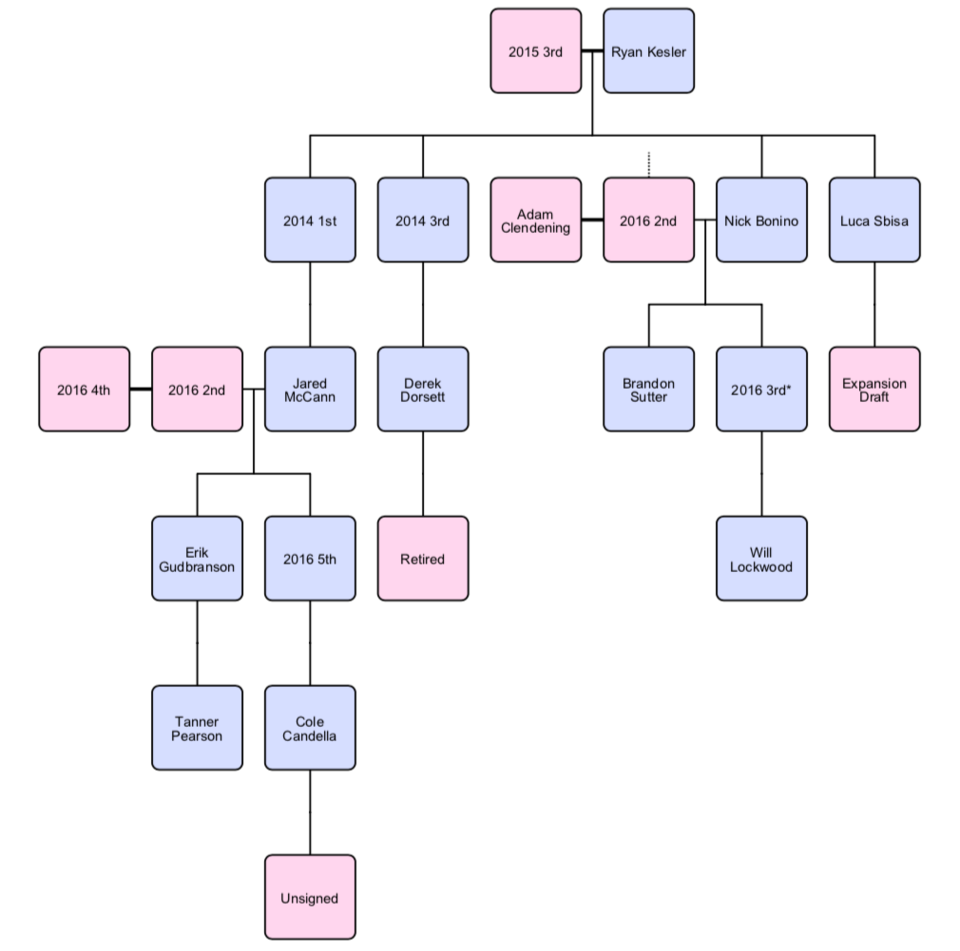
You might need to open up that picture to see the whole thing, but here’s the end result of the Kesler trade: Tanner Pearson, Brandon Sutter, and Will Lockwood.
The first-round pick became Jared McCann, who was subsequently traded with two more picks for Erik Gudbranson, who was traded for Pearson.
The third-round pick was immediately traded for Derek Dorsett, who subsequently had to retire due to a scary neck injury.
Sbisa was claimed by the Vegas Golden Knights in the expansion draft.
Bonino was traded to the Pittsburgh Penguins as part of a package to acquire Brandon Sutter. The Canucks also got a third-round pick in the deal, with which they drafted Will Lockwood. There’s an asterisk on that third-round pick for a reason: we’ll see it again in just a little bit.
How you view the eventual outcome of the Kesler trade probably depends on how highly you view Pearson, Sutter, and Lockwood. The initial return looks decent in retrospect, but how it played out is more underwhelming.
The other trade trees aren’t quite as complicated. The other trade from June 27, 2014 was the Jason Garrison deal, moving out the Canucks’ top-scoring defenceman from 2013-14 for a second-round pick.
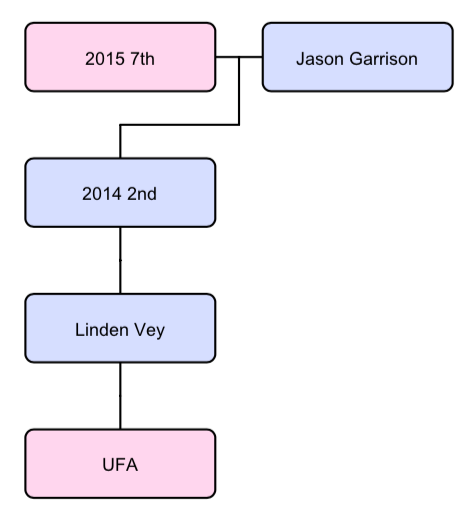
That second-round pick was traded the next day to the Los Angeles Kings for Linden Vey, who last two seasons with the Canucks before leaving in free agency after he didn’t receive a qualifying offer.
So, that didn’t work out too well. Would the Canucks have been better off using that second-round pick instead of trading it? Perhaps, but there’s some hindsight at work there.
The next trade chronologically is a fun one, as long as we skip over the far more boring Kellan Lain for Will Acton trade. Remember Alexandre Mallet?
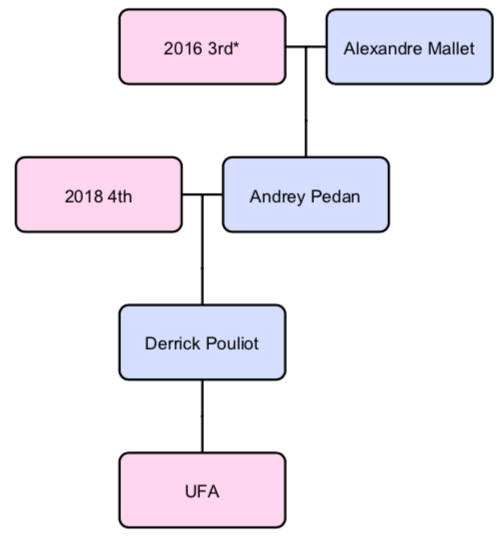
Mallet was moved with a third-round pick to the New York Islanders for defenceman Andrey Pedan, who was eventually moved with a fourth-round pick to the Pittsburgh Penguins for Pouliot.
That’s right, how we get from the 2013-14 Canucks roster to Pouliot is via Alexandre Mallet, of all players. What’s fun, however, is that third-round pick. Remember the asterisk up above?
The Canucks’ 2016 third-round pick that went to the Islanders in the Mallet/Pedan trade was then traded to the Buffalo Sabres as part of the Michael Neuvirth trade. Then, when the Sabres hired Dan Bylsma as their new head coach in 2015, the pick was claimed by the Pittsburgh Penguins as compensation, since Bylsma was still under contract to the Penguins.
Eventually it all came back around: the third-round pick that the Canucks acquired in the Bonino/Sutter trade was their own pick, having gone through three different teams before making its way back to the Canucks. Weird.
Benning got decent value in the Eddie Lack trade.
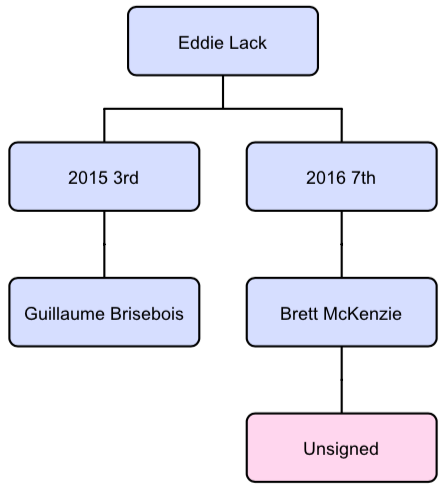
Other than using the 2014 first-round pick to take Jared McCann, these were the only two draft picks that Benning actually used to pick players out of the 2013-14 season. Guillaume Brisebois is still with the Canucks and has received a lot of praise from Benning and Canucks management. McKenzie went unsigned.
Here’s another odd one: the Kevin Bieksa deal.
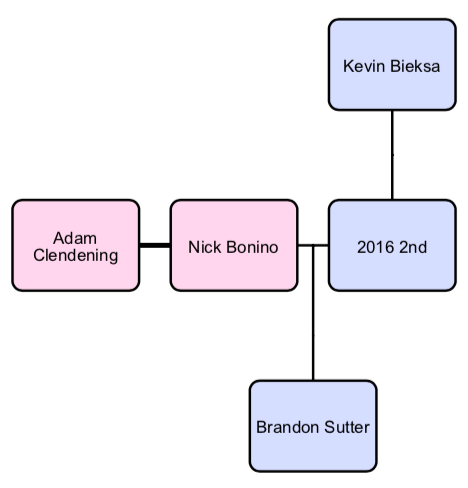
Getting a second-round pick for a declining Bieksa was a pretty solid deal. Bieksa struggled over three seasons with the Ducks, then retired.
The issue was the Canucks didn’t use the second-round pick. Instead, it was included in the Bonino/Sutter trade. Ultimately, the return for Bieksa got folded into the return for Kesler.
Then there’s the Zack Kassian trade.
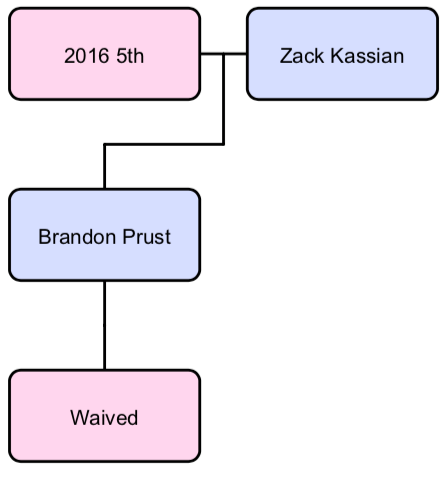
This was an odd situation. The Canucks felt they had to move Kassian due to his alcoholism, which he’s been open about since. Perhaps the Canucks did everything they could to help him (though the language they used about Kassian left something to be desired) and the trade was necessary. The return in the trade, however, was awful, even considering the circumstances.
In 2016, there was the trade of prospect Nicklas Jensen and a sixth-round pick for Emerson Etem. Etem was eventually waived and claimed by the Ducks.
Then there was the trade of Hunter Shinkaruk to the Calgary Flames for Markus Granlund, which worked out primarily because Shinkaruk ended up being a bust and Granlund, at the very least, is an NHL player. Granlund is still with the Canucks, though he is an RFA and needs a new contract.
Other than Jordan Subban getting traded for Nic Dowd, who left in free agency, and Darren Archibald getting tossed into the Anders Nilsson trade, there are only two trades left. They’re the two most significant of the “traditional” rebuilding moves that Benning has made: the Jannik Hansen and Alex Burrows trades.
The Alex Burrows trade tree is pretty straightforward, even if the circumstances surrounding it are still somewhat a mystery. Burrows was traded to the Ottawa Senators for prospect Jonathan Dahlen, who subsequently requested a trade (or maybe didn’t) after part of a season in Utica.
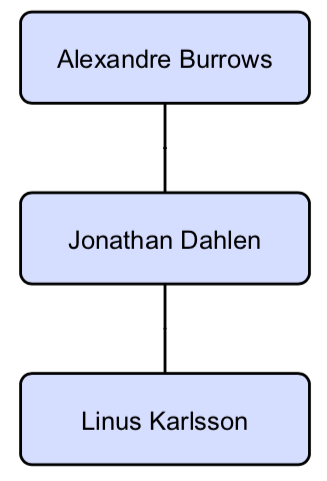
What’s left is Linus Karlsson, a lower-tier prospect that might still have an NHL future with his all-around game. We’ll see.
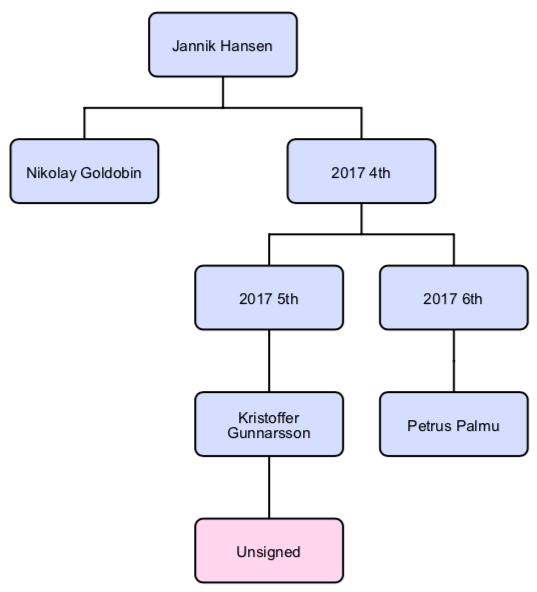
The Jannik Hansen trade has borne a little more fruit. Nikolay Goldobin’s future with the Canucks is uncertain, but he’s shown flashes of being a legitimate top-six forward.
Meanwhile, the fourth-round pick in the deal was flipped for two later picks, allowing the Canucks to take a chance on Kristoffer Gunnarsson and Petrus Palmu. Gunnarsson has gone unsigned, but Palmu still has some potential. That said, he left the Utica Comets for Finland last season, so there might be a rift between Palmu and the Canucks organization.
Palmu finished his Liiga season with 18 points in 29 games: decent, but not spectacular production. He was top-10 in points per game among players 21 and under, which suggests there may still be some potential there.
After all that, what are the Canucks left with from what remains of the 2013-14 Canucks roster? Let’s take the players and make a little lineup, just to get a better look:
What do you think? Did Benning do enough with the roster he inherited?
What stands out to me is the pattern of acquiring picks then immediately using those picks to acquire roster players. Another pattern is the addition of draft picks to several trades. Given the Canucks’ decent record at the draft table over the last several years, it’s hard to avoid thinking that the Canucks would have been better off letting Benning and Judd Brackett use those picks instead.
